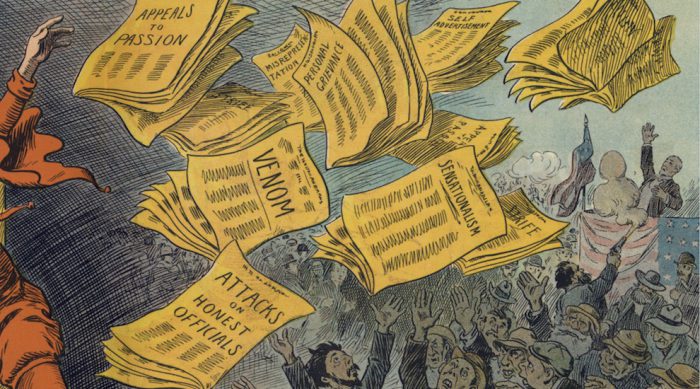
The growing stream of reporting on and data about fake news, misinformation, partisan content, and news literacy is hard to keep up with. This weekly roundup offers the highlights of what you might have missed.
Harvard librarians probably didn’t guess the blowback they were in for when they published this innocent online guide to “Fake News, Misinformation, and Propaganda”. The guide, which includes otherwise useful/basic tips like “using library databases is a near-foolproof way to find credible information”, also links to Merrimack College professor Melissa Zimdars’ sprawling and much-debated list of “False, Misleading, Clickbait-y, and/or Satirical ‘News’ Sources,” which currently includes 921 sites tagged in a number of categories including “fake,” “satire,” “conspiracy,” “unreliable,” and “political.” Sites like Fusion, National Review, and The Onion are listed alongside actual fake news sites like denverguardian.com and David Duke’s website. (Also on the list: IJR, the only site that got a reporter on Secretary of State Rex Tillerson’s plane to Asia, and which had a retracted-article snafu just yesterday.)
It’s confusing, to say the least, and Harvard’s inclusion of this list in its guide has led to a lot of criticism as well as accusations that the entire guide was actually written by Zimdars, which it was not. (Nor is her list “a Harvard study.” Also, for the record, Nieman Lab is part of Harvard, but we didn’t have anything to do with it.) “Instead of targeting stories that are completely false…the Left applies the label of ‘fake news’ to outlets that report factual stories but draw political conclusions from them — in other words, they call everything with which they disagree ‘fake news,'” The Daily Wire’s Ben Shapiro wrote in National Review. (The left: not the only culprit here.) Washington Examiner’s T. Becket Adams interviewed Zimdars and suggests, “One problem with her database is that it groups 100 percent false stories, which are knowingly fabricated from thin air, with coverage she deems either too political, too clickbait-y or generally unreliable. There’s an obvious difference, however, between what the Daily Caller does and what a group of fake news teens in Macedonia do. Perhaps separate lists would help.”
When Harvard first published its research guide, it described Zimdars’ list as a “huge list of fake news sites.” That’s been updated to “An informal list compiled by students for a class taught by Melissa Zimdars at Merrimack College.”
Kremlin-affiliated site Russia Today also launched a fake-news-detecting site called FakeCheck. “It’s almost hard to remember now, but the concept of ‘fake news’ was largely nonpartisan as recently as five months ago, when it referred mostly to intentionally fabricated stories from faux outlets posing as real news organizations…” Will Oremus wrote at Slate. “Now, it seems, ‘fake news’ can mean ‘news that runs counter to the interests of Russian propaganda organizations.'”
Whoopi Goldberg says she’s suing James McDaniel, the guy behind the “satirical” fake news site The Underground Report that I covered last week. (The site “reported” that Goldberg had condemned Carryn Owens, the widow of the Navy SEAL killed in January’s Yemen raid.) “If you’re going to involve someone in fake news, you should have their permission. You shouldn’t be able to put stuff out there, ’cause clearly you don’t care what could’ve happened to me or to my family,” she said on The View on Monday. The Underground Report has been taken down; McDaniel claimed (in a now-cached post) that while “it is true that when I started the website I was mostly playing and not expecting to gain a ton of attention for my work, by the time I wrote the story about Goldberg, the project had grown into a full-blown experiment with significant social and political consequences involving the spread and belief in off the wall fake news stories and how they relate to confirmation bias and cognitive dissonance in individuals who touted them.” The responsibility, he argued, lies with readers: “Why had Whoopi singled me out and not placed virtually any of the responsibilities on the people who read and shared the articles, often accompanied with captions of intense hatred? Why was the bigger problem of today’s fake news culture perpetuated by readers not a greater target of criticism?” (Related-ish, Mark Zuckerberg this week: “No one in our community wants fake information. Everyone wants real information.”)
“[Facebook and Google] have a lot more might to deal with this than send people to conferences to say ‘we’re working on this'” — Jonny Hornby, of marketing company The&Partnership, on digital giants’ role in combating ad fraud.
“You spread stories because you know that they’re likely to be a kind of litmus test, and the way people react will show whether they’re prepared to side with you or not.” Julie Beck takes a look at why it’s so hard to change people’s minds, in The Atlantic. Anthropologist and psychologist Pascal Boyer: “If you encounter 10 people who seem to have roughly the same idea, then it fools your system into thinking that it must be a probable idea because lots of people agree with it. One thing you assume, unconsciously, is that these 10 people came to the same belief independently. You don’t think that nine of these are just repeating something that the 10th one said.”